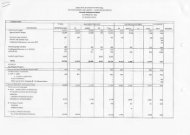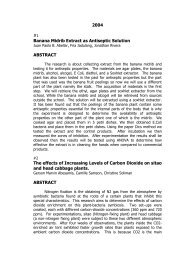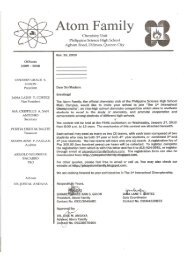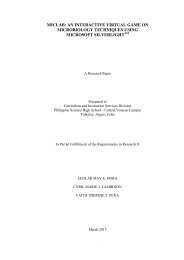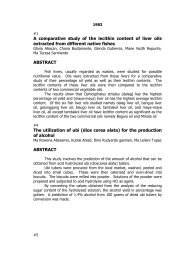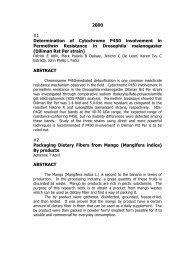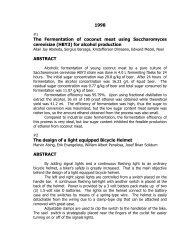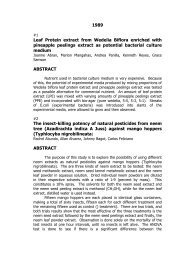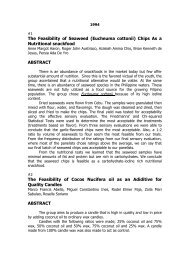2008 Analysis of the Geometry of Drilled Holes in Demolition ...
2008 Analysis of the Geometry of Drilled Holes in Demolition ...
2008 Analysis of the Geometry of Drilled Holes in Demolition ...
Create successful ePaper yourself
Turn your PDF publications into a flip-book with our unique Google optimized e-Paper software.
#27<br />
Feasibility <strong>of</strong> Solanum melongena Peel<strong>in</strong>gs Extract as a pH<br />
Indicator<br />
Joseph Angelo S. Chu, Kev<strong>in</strong> Thomas B. Go, Emmanuel Johann G. Peña III<br />
ABSTRACT<br />
This project aimed to develop a work<strong>in</strong>g pH <strong>in</strong>dicator us<strong>in</strong>g <strong>the</strong><br />
anthocyan<strong>in</strong>-conta<strong>in</strong><strong>in</strong>g extract from <strong>the</strong> peels <strong>of</strong> Solanum melongena, more<br />
commonly known as eggplant. The study dealt with extract<strong>in</strong>g <strong>the</strong> anthocyan<strong>in</strong> <strong>of</strong><br />
<strong>the</strong> eggplant peels by boil<strong>in</strong>g it <strong>in</strong> distilled water. The extract was <strong>the</strong>n tested on<br />
certa<strong>in</strong> test chemicals, correspond<strong>in</strong>g to certa<strong>in</strong> pH levels (4, 7, and 10). Dur<strong>in</strong>g<br />
<strong>the</strong> tests <strong>the</strong> extract was observed to exhibit a color change <strong>in</strong> each test solution<br />
chemicals. Aside from <strong>the</strong> <strong>in</strong>itially colored pH buffer solutions, o<strong>the</strong>r colorless<br />
solutions like acetic acid (v<strong>in</strong>egar) and liquid detergent, which yielded different<br />
color changes, were used to show that <strong>the</strong> extract did not just mix its color with<br />
<strong>the</strong> test chemical. Success <strong>in</strong> this study will greatly help <strong>in</strong>struction <strong>in</strong>volv<strong>in</strong>g pH<br />
because <strong>of</strong> <strong>the</strong> simple procedure and accessibility and availability <strong>of</strong> eggplants.<br />
#28<br />
Mussel Shells as an Alternative Aggregate to Sand<br />
In Concrete Mak<strong>in</strong>g<br />
Fatima R. Cipriano, Jest<strong>in</strong>e A. Mariano, Pierre Emanuelle N. Santos<br />
ABSTRACT<br />
This project is about <strong>the</strong> replacement <strong>of</strong> sand as f<strong>in</strong>e aggregate <strong>in</strong> class A<br />
concrete mix. It aimed to f<strong>in</strong>d uses for waste mussel shells, and to provide a<br />
cheap way for fishermen to build <strong>the</strong>ir houses. Specifically, it tested <strong>the</strong> effect <strong>of</strong><br />
<strong>the</strong> addition <strong>of</strong> <strong>the</strong> mussel shells to sand and cement mixture <strong>in</strong> class A concrete<br />
mix.<br />
The water, cement, and gravel (coarse aggregate) weight ratio were kept<br />
constant with <strong>the</strong> standard mix. Only <strong>the</strong> sand component was changed to pure<br />
crushed mussel shells procured from a wet market.<br />
First, <strong>the</strong> mussel shells were pounded us<strong>in</strong>g mortar and pestle. The small<br />
shells were placed <strong>in</strong> <strong>the</strong> Wiley Mill for fur<strong>the</strong>r gr<strong>in</strong>d<strong>in</strong>g. The cement to f<strong>in</strong>e<br />
aggregate to coarse aggregate ratio was <strong>the</strong>n set to 1:2:3. A kilogram <strong>of</strong> cement,<br />
four kilograms (4kg) <strong>of</strong> mussel shells, and six kilograms (6 kg) were brought to<br />
<strong>the</strong> lab and were mixed <strong>in</strong> a half-bag mixer <strong>in</strong> order to yield three (3) samples.<br />
However, <strong>the</strong> <strong>the</strong>oretical yield wasn’t achieved because some <strong>of</strong> <strong>the</strong> concrete mix<br />
was stuck <strong>in</strong> <strong>the</strong> mixer. Two samples were made from <strong>the</strong> <strong>in</strong>gredients.<br />
After 28 days, <strong>the</strong> samples were tested for <strong>the</strong>ir compressive strength and<br />
unit weight. Their unit weights were near standard which is 2400 kg/ cm 3 .



